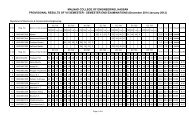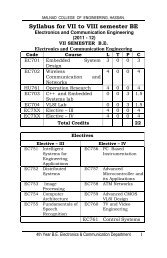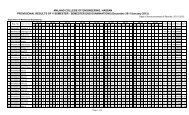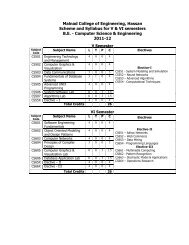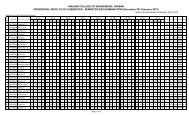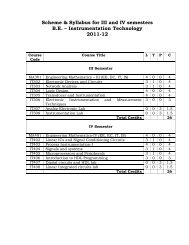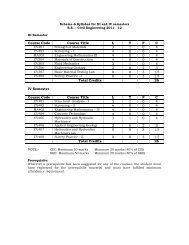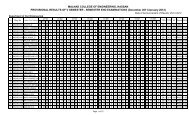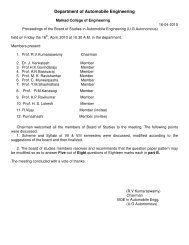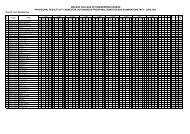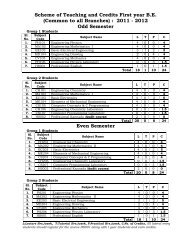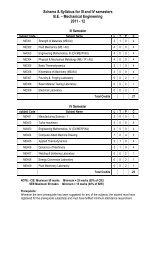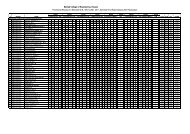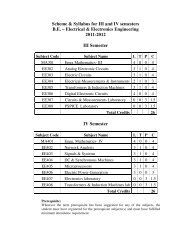Scheme & Syllabus for VII and VIII semesters BE - Malnad College ...
Scheme & Syllabus for VII and VIII semesters BE - Malnad College ...
Scheme & Syllabus for VII and VIII semesters BE - Malnad College ...
You also want an ePaper? Increase the reach of your titles
YUMPU automatically turns print PDFs into web optimized ePapers that Google loves.
<strong>Scheme</strong> & <strong>Syllabus</strong> <strong>for</strong> <strong>VII</strong> <strong>and</strong> <strong>VII</strong>I <strong>semesters</strong><br />
B.E. – Instrumentation Technology<br />
2011-12<br />
<strong>VII</strong> semester<br />
Course<br />
Course Title L T P C<br />
Code<br />
IT701 DSP Architecture 4 0 0 4<br />
IT702 PLC’S <strong>and</strong> DCS in process control<br />
4 0 0 4<br />
automation<br />
IT703 Neural Networks <strong>and</strong> Applications 4 0 0 4<br />
IT704 DSP Lab 0 0 3 1.5<br />
IT705 Process Control Instrumentation Lab 0 0 3 1.5<br />
IT7XX<br />
IT7XX<br />
IT7XX<br />
Course<br />
Code<br />
Elective – III<br />
Elective – IV<br />
Elective – V<br />
3<br />
3<br />
3<br />
0<br />
0<br />
0<br />
0<br />
0<br />
0<br />
3<br />
3<br />
3<br />
Total Credits 24<br />
Course Title L T P C<br />
Elective III<br />
IT731 Micro <strong>and</strong> smart system Technology 3 0 0 3<br />
IT732 System Modeling 3 0 0 3<br />
IT733 Wavelet Trans<strong>for</strong>ms 3 0 0 3<br />
Elective IV<br />
IT741 ARM Processor 3 0 0 3<br />
IT742 Embedded System & RTOS 3 0 0 3<br />
IT743 Visual Basics 3 0 0 3<br />
IT744 VLSI Design 3 0 0 3<br />
Elective V<br />
IT751 Biomedical Digital Signal Processing 3 0 0 3<br />
IT752 Speech Signal Processing 3 0 0 3<br />
IT753 Aircraft Instrumentation 3 0 0 3<br />
<strong>VII</strong>I semester<br />
Course Course Title L T P C<br />
Code<br />
IT801 Engineering Management Techniques 4 0 0 4<br />
IT802 Intellectual Property Rights 3 0 0 3<br />
IT803 Seminar on Advanced Topics 0 0 - 2<br />
IT804 Project Work & Seminar 0 0 - 9<br />
IT8XX Elective VI Students can opt 4 - 0 4*<br />
IT8XX Elective <strong>VII</strong><br />
any one of the<br />
elective to meet<br />
3 - 0 3**<br />
required credits<br />
Total Credits 22*/21**
Course<br />
Code<br />
Electives<br />
Course Title L T P C<br />
Elective-VI<br />
IT861 Smart Sensors 4 0 0 4<br />
IT862 Robotics 4 0 0 4<br />
IT863 Nano -Technology <strong>and</strong> Applications 4 0 0 4<br />
IT864 Lasers & Optical Instrumentation 4 0 0 4<br />
Elective-<strong>VII</strong><br />
IT871 Computer vision 3 0 0 3<br />
IT872 Java <strong>and</strong> Introduction to J2EE 3 0 0 3<br />
IT873 Pattern Recognition 3 0 0 3<br />
IT874 Medical Imaging 3 0 0 3<br />
<strong>VII</strong> SEMESTER<br />
IT701-DSP ARCHITECTURE (4-0-0) 4<br />
1. Introduction to Digital Signal Processing: Introduction, A digital signal processing<br />
system, the sampling process, discrete time sequences, Discrete Fourier Trans<strong>for</strong>m (DFT)<br />
<strong>and</strong> Fast Fourier Trans<strong>for</strong>m (FFT), linear time invariant systems, Digital filters, Decimation<br />
<strong>and</strong> Interpolation, Analysis <strong>and</strong> Design tool <strong>for</strong> DSP systems.<br />
7 Hours<br />
2. Computational Accuracy in DSP Implementation: Introduction, Number <strong>for</strong>mats <strong>for</strong><br />
signals <strong>and</strong> coefficients in DSP systems, Dynamic range <strong>and</strong> precision, Sources of error in<br />
DSP implementations, A/D conversion error, DSP computational error <strong>and</strong> D/A Conversion<br />
error.<br />
7 Hours<br />
3. Digital Signal Processing Devices: Introduction, Basic architectural features, DSP<br />
computational building blocks, Bus architecture <strong>and</strong> memory, Data addressing capabilities,<br />
Address generation unit, Programmability <strong>and</strong> Program execution, Speed issues.<br />
6 Hours<br />
4. Programmable Digital Signal Processors: Introduction, Architecture of TMS320C54xx<br />
digital signal processors: Bus structure, Central processing unit, internal memory <strong>and</strong><br />
memory mapped registers, Data addressing modes of TMS320C54xx processors, Memory<br />
space of TMS320C54xx processors.<br />
7 Hours<br />
5. TMS 320c54xx Instructions And Programming, On-chip peripherals, Interrupts of<br />
TMS320C54xx processors, Pipeline operation of TMS320C54xx processors.<br />
6 Hours<br />
6. Implementation of Basic DSP Algorithms: Introduction, The Q-notation, FIR Filters, IIR<br />
Filters, Interpolation Filters, Decimation Filters, Adaptive Filters, butterfly computation,<br />
FFT implementation on the TMS320C54xx<br />
7 Hours<br />
7. Interfacing Memory <strong>and</strong> Parallel I/O Peripherals to Programmable DSP Devices:<br />
Introduction, Memory space organization, External bus interfacing signals, Memory<br />
interface, Parallel I/O interface, Programmed I/O, Interrupts <strong>and</strong> I/O, Direct memory<br />
access (DMA). Interfacing Serial Converters to a Programmable DSP device: Introduction,<br />
Synchronous Serial Interface (SSI), A multi channel buffered serial port (McBSP).<br />
6 Hours
8. A Codec Interface Circuit: CODEC-DSP interface circuit. Applications of programmable<br />
DSP devices: Introduction, A DSP system, DSP-based Biotelemetry receiver, A speech<br />
processing system, An image processing system.<br />
6 Hours<br />
Text Book:<br />
1. Digital Signal Processing-Avtar Singh <strong>and</strong> S. Srinivasan, Thomson Publishing, 2004,<br />
Singapore.<br />
Reference Books:<br />
1. Digital Signal Processing- A Practical Approach, Emmanuel C Ifeachor <strong>and</strong> B W Jervis,<br />
Pearson Education, New Delhi.<br />
2. Digital Signal Processors- B Venkataramani <strong>and</strong> M Bhaskar, Tata-McGraw Hill, New<br />
Delhi, 2002.<br />
IT702- PLC AND DCS FOR PROCESS CONTROL AUTOMATION (4-0-0) 4<br />
1. Overview of plant Automation Concepts <strong>and</strong> Introduction to PLC<br />
Aims of plant automation, Classical approaches of Plant Automation, Computer based Plant<br />
Automation Concepts, Distributed Computer Control.<br />
Introduction to PLCs: Basics of PLCs, Innovations incorporated in to the programmable<br />
Controller, Introduction to fixed <strong>and</strong> modular PLC hardware, <strong>and</strong> the central Processing Unit<br />
2. Introduction to programming Techniques <strong>and</strong> Logic<br />
6 Hours<br />
H<strong>and</strong> held Programming Terminals, desktop PCs <strong>and</strong> PLC programming, the IEC 1131-3<br />
programming st<strong>and</strong>ard; ladder diagram, Functional Block diagram, sequential flow Chart.<br />
Introduction to Logic: Conventional Ladder versus PLC Ladder logic, what is Logic<br />
Implementation <strong>and</strong> analysis of logic functions; AND, OR, NOT <strong>and</strong> EX-OR using Ladder<br />
diagram <strong>and</strong> Functional Block diagram techniques, Conventional Logic <strong>and</strong> priority of logic<br />
elements.<br />
3. Introduction to Digital <strong>and</strong> Analog PLC Interface<br />
7 Hours<br />
The digital Concept, the input <strong>and</strong> output status files <strong>and</strong> fixed PLCs, 16 point I/O Modules<br />
with Decimal Addressing, Fixed PLC I/O Addressing when I/O is exp<strong>and</strong>ed, 32 bit control Logic<br />
PLC, Analog I/O interface to the PLC.<br />
4. Input <strong>and</strong> Output Modules of PLCs<br />
6 Hours<br />
Input Modules: Discrete input AC Module, DC input Module, Sinking <strong>and</strong> sourcing, Solid state<br />
interface to DC input Modules.<br />
Output Modules: Discrete output Modules, Relay output Modules, model selection<br />
consideration, criteria to choose the proper output module, isolated output module, Interposing<br />
Relays, surge suppression <strong>and</strong> Output modules, analog output modules.<br />
5. PLC Instructions –I:<br />
7 Hours<br />
The Basic Relay Instructions, The Normally OPEN <strong>and</strong> normally CLOSED Instructions, the one<br />
shot Instruction, The output latching Instruction, the negated output Instruction.<br />
Underst<strong>and</strong>ing Relay instructions <strong>and</strong> the programmable controller Input Modules: Interfacing<br />
a Start-Stop Push Button station <strong>and</strong> Motor to a PLC.<br />
Construction of Ladder diagram <strong>for</strong> analytical problems.<br />
6. PLC Instructions –II:<br />
6 Hours
Timer instructions: Timer instructions, the ON – delay Timer <strong>and</strong> OFF delay Timer instructions,<br />
the retentive timer Instruction, The RESET Instruction.<br />
Counter Instructions: the Count Up <strong>and</strong> Count down Instruction, The counter Reset <strong>and</strong> Clear<br />
Instruction, Combining Counters <strong>and</strong> Timers.<br />
Construction of Ladder diagram <strong>for</strong> analytical problems.<br />
7. PLC Instructions –III:<br />
7 Hours<br />
Comparison <strong>and</strong> Data h<strong>and</strong>ling Instructions: comparison, Data h<strong>and</strong>ling <strong>and</strong> Logical<br />
Instructions.<br />
Sequencer Instructions: The Sequencer Instructions, Programming the output Sequencer<br />
Instructions.<br />
Construction of Ladder diagram <strong>for</strong> analytical problems.<br />
6 Hours<br />
8. Introduction to SCADA <strong>and</strong> DCS:<br />
Supervisory Control <strong>and</strong> data Acquisition System: Channel Scanning, Data Processing,<br />
distributed SCADA Structure; Star <strong>and</strong> daisy Chain configuration<br />
Distributed Control Systems: Distributed dedicated, Centralised <strong>and</strong> decentralised Computer<br />
Control Concept.<br />
Functional Requirements of DCS, System architecture, Functional Levels of DCS, Sub Systems;<br />
Presentation <strong>and</strong> Monitoring Devices, Communication links in DCS.<br />
7 Hours<br />
Text Books:<br />
1. Introduction to Programmable Logic Controllers by Garry Dunning, 3 nd edition, Cent age<br />
learning. (Chapters:1, 3 &6, 5, 7 & 8, 13 &14, 16, 17 & 18).<br />
2. Computer based Industrial Control by Krishna Kant, PHI.( Chapters 1, 3 & 6)<br />
Reference Books:<br />
1. Process Control Instrumentation technology by Curtis Johnson, 4 th Edition PHI.(Chapter<br />
8 – <strong>for</strong> analytical problems)<br />
IT703- NEURAL NETWORKS AND APPLICATIONS (4-0-0) 4<br />
1. Introduction: Human Brain, Models of a Neuron, Neural Networks viewed as directed graphs,<br />
Feedback, Network architectures, Knowledge Representation, Artificial Intelligence <strong>and</strong> Neural<br />
Networks<br />
6 Hours<br />
2. Learning Processes: Introduction, Error correction algorithm, Memory based learning, Hebbian<br />
Learning, Competitive learning, Boltzmann learning, learning with a teacher, learning without a<br />
teacher.<br />
7 Hours<br />
3. Single Layer Perceptrons: Learning tasks, Memory, Adaptation Introduction, Perceptron, <strong>and</strong><br />
perception convergence theorem, Relation between the Perceptron <strong>and</strong> Baye’s classifier <strong>for</strong> a<br />
Gaussian environment.<br />
6 Hours<br />
4. Multilayer Perceptron-I: Introduction, Some preliminaries, Back Propagation Algorithm,<br />
Summary of the Back Propagation Algorithm, XOR Problem <strong>and</strong> Heuristics <strong>for</strong> making the Back<br />
propagation algorithm to per<strong>for</strong>m better, Output representation <strong>and</strong> decision rule.<br />
7 Hours<br />
5. Multilayer Perceptron-II: Feature detection, Back-propagation <strong>and</strong> differentiation, Hessian<br />
matrix, Generalization, Approximations of functions, Cross validation, Network pruning<br />
techniques, Virtues <strong>and</strong> limitations of Back-propagation learning, Accelerated convergence of<br />
Back-propagation learning.<br />
6 Hours<br />
6. Radial Basis Function Networks: Architecture, Cover’s theorem on the separability of Patterns,<br />
Generalized Radial Basis function networks (RBF), Approximation properties of RBF networks,
Comparison of RBF networks <strong>and</strong> Multi layer Perceptrons, learning strategies, Applications.<br />
7Hours<br />
7. Self-organizing Maps: Introduction, Basic feature mapping models, Self-organizing map (SOM),<br />
Summary of the SOM algorithm, properties of the feature map, Applications<br />
6 Hours<br />
8. Hopfield Networks: Architecture, Storage Capacity of Hopfield models, Energy analysis of<br />
continuous <strong>and</strong> discrete Hopfield networks, State transition diagram, Pattern storage by<br />
computation of weights.<br />
7 Hours<br />
Text Books:<br />
1. Neural Networks- A Comprehensive Foundation, Simon Haykin, Prentice-Hall India,<br />
Second Edition, 2005.<br />
Reference Books:<br />
1. Introduction to Artificial Neural Networks, S. N. Sivan<strong>and</strong>am <strong>and</strong> M Paulraj, Vikas<br />
Publishing, First edition, 2003.<br />
2. Artificial Neural Networks, B. Yegnanarayana, Prentice-Hall India, First edition, 1999.<br />
1. Verify the Sampling theorem.<br />
IT704 DSP LAB (0-0-3)1.5<br />
2. Determine linear convolution, Circular convolution <strong>and</strong> Correlation of two given sequences.<br />
Verify the result using theoretical computations.<br />
3. Determine the linear convolution of two given point sequences using FFT algorithm.<br />
4. Determine the correlation using FFT algorithm.<br />
5. Determine the spectrum of the given sequence using FFT.<br />
6. Design <strong>and</strong> implementation of FIR filter using Windowing technique <strong>for</strong> the given order <strong>and</strong><br />
cut-off frequency.<br />
7. Design <strong>and</strong> implementation of FIR filter using frequency sampling technique.<br />
8. Design <strong>and</strong> implementation of Butterworth 1 st <strong>and</strong> 2 nd order low pass filter.<br />
9. Design <strong>and</strong> implementation of Butterworth 1 st <strong>and</strong> 2 nd order high pass filter.<br />
10. Design <strong>and</strong> implementation of Chebyshev 1 st <strong>and</strong> 2 nd order low pass filter.<br />
11. Design <strong>and</strong> implementation of Chebyshev 1 st <strong>and</strong> 2 nd order high pass filter.<br />
12. Generation <strong>and</strong> detection DTMF signal using MATLAB software only.<br />
Note: Implementation of 1-11 Experiments using DSP Kit <strong>and</strong> verification of results<br />
using MATLAB.<br />
IT705 PROCESS CONTROL INSTRUMENTATION LAB (0-0-3)1.5<br />
1. Design <strong>and</strong> test the circuit to display the temperature using RTD with suitable signal<br />
conditioning circuit.<br />
2. Design <strong>and</strong> test the circuit to display the temperature using THERMISTOR with suitable<br />
signal conditioning circuit.<br />
3. Design <strong>and</strong> test the circuit to display the temperature using Thermocouple with suitable<br />
signal conditioning circuit
4. Design <strong>and</strong> test the circuit to display the temperature using AD590 with suitable signal<br />
conditioning circuit.<br />
5. Design <strong>and</strong> test the circuit to display the load using load cell with suitable signal<br />
conditioning circuits.<br />
6. Design <strong>and</strong> test the circuit to display the displacement using LVDT with suitable signal<br />
conditioning circuit.<br />
7. Using different controllers obtain the optimum response of the given temperature<br />
controller.<br />
8. Using different controllers obtain the optimum response of the given flow controller.<br />
9. Using different controllers obtain the optimum response of the given level controller.<br />
10. Develop the Ladder diagram <strong>for</strong> various discrete state systems <strong>and</strong> simulate using PLC.<br />
11. Develop the ladder diagram <strong>for</strong> Bottle filling process <strong>and</strong> conduct an experiment using PLC.<br />
12. Develop the ladder diagram <strong>for</strong> elevator system <strong>and</strong> conduct an experiment using PLC.<br />
IT731 MICRO AND SMART SYSTEMS TECHNOLOGY (3-0-0) 3<br />
1. Introduction to Micro <strong>and</strong> Smart Systems:<br />
a) What are smart-material systems Evolution of smart materials, structures <strong>and</strong> systems.<br />
Components of a smart system. Application areas. Commercial products.<br />
b) What are microsystems Feynman’s vision. Micromachined transducers. Evolution of micromanufacturing.<br />
Multi-disciplinary aspects. Applications areas. Commercial products.<br />
5 Hours<br />
2. Micro <strong>and</strong> Smart Devices <strong>and</strong> Systems: Principles <strong>and</strong> Materials<br />
a) Definitions <strong>and</strong> salient features of sensors, actuators, <strong>and</strong> systems.<br />
b) Sensors: silicon capacitive accelerometer, piezo-resistive pressure sensor, blood analyzer,<br />
conductometric gas sensor, fiber-optic gyroscope <strong>and</strong> surface-acoustic-wave based wireless<br />
strain sensor.<br />
c) Actuators: silicon micro-mirror arrays, piezo-electric based inkjet print-head, electrostatic<br />
comb-drive <strong>and</strong> micromotor, magnetic micro relay, shape-memory-alloy based actuator,<br />
electro-thermal actuator<br />
d) Systems: micro gas turbine, portable clinical analyzer, active noise control in a helicopter<br />
cabin<br />
5 Hours<br />
3. Micromanufacturing <strong>and</strong> Material Processing:<br />
a) Silicon wafer processing, lithography, thin-film deposition, etching (wet <strong>and</strong> dry), wafer<br />
bonding, <strong>and</strong> metallization.<br />
b) Silicon micromachining: surface, bulk, moulding, bonding based process flows.<br />
c) Thick-film processing:<br />
d) Smart material processing:<br />
e) Processing of other materials: ceramics, polymers <strong>and</strong> metals<br />
f) Emerging trends<br />
4. Modelling:<br />
5 Hours
a) Scaling issues.<br />
b) Elastic de<strong>for</strong>mation <strong>and</strong> stress analysis of beams <strong>and</strong> plates. Residual stresses <strong>and</strong> stress<br />
gradients. Thermal loading. Heat transfer issues. Basic fluids issues.<br />
c) Electrostatics. Coupled electromechanics. Electromagnetic actuation. Capillary electrophoresis.<br />
Piezoresistive modeling. Piezoelectric modeling. Magnetostrictive actuators.<br />
5 Hours<br />
5. Computer-Aided Simulation <strong>and</strong> Design: Background to the finite element element method.<br />
Coupled-domain simulations using Matlab. Commercial software.<br />
5 Hours<br />
6. Electronics Circuits <strong>and</strong> Control: Carrier concentrations, semiconductor diodes, transistors,<br />
MOSFET amplifiers, operational amplifiers. Basic Op-Amp circuits. Charge-measuring circuits.<br />
Examples from microsystems. Transfer function, state-space modeling, stability, PID controllers,<br />
<strong>and</strong> model order reduction. Examples from smart systems <strong>and</strong> micromachined accelerometer or a<br />
thermal cycler.<br />
5 Hours<br />
7. Integration <strong>and</strong> Packaging of Micro Electro- Mechanical Systems: Integration of<br />
microelectronics <strong>and</strong> micro devices at wafer <strong>and</strong> chip levels. Microelectronic packaging: wire <strong>and</strong><br />
ball bonding, flip-chip. Low-temperature-cofired-ceramic (LTCC) multi-chip-module technology.<br />
Microsystem packaging examples.<br />
5 Hours<br />
8. Case Studies: <strong>BE</strong>L pressure sensor, thermal cycler <strong>for</strong> DNA amplification, <strong>and</strong> active vibration<br />
control of a beam.<br />
5 Hours<br />
Text Book:<br />
1. MEMS & Microsystems: Design <strong>and</strong> Manufacture- Tai-Ran Tsu, Tata Mc-Graw-Hill.<br />
Reference Books:<br />
1. Animations of Working Principles, Process Flows <strong>and</strong> Processing Techniques- A CDsupplement<br />
with Matlab codes, photographs <strong>and</strong> movie clips of processing machinery <strong>and</strong><br />
working devices.<br />
2. Laboratory Hardware Kits For- (i) <strong>BE</strong>L pressure sensor, (ii) thermal-cycler <strong>and</strong> (iii) active<br />
control of a cantilever beam.<br />
3. Microsystems Design- S. D. Senturia, 2001, Kluwer Academic Publishers, Boston, USA.<br />
ISBN 0-7923-7246-8.<br />
4. Analysis <strong>and</strong> Design Principles of MEMS Devices-Minhang Bao, Elsevier, Amsterdam,<br />
The Netherl<strong>and</strong>s, ISBN 0-444-51616-6.<br />
5. Design <strong>and</strong> Development Methodologies-Smart Material Systems <strong>and</strong> MEMS: V.<br />
Varadan, K. J. Vinoy, S. Gopalakrishnan, Wiley.<br />
6. MEMS- Nitaigour Premch<strong>and</strong> Mahalik, Tata McGraw Hill 2007.<br />
IT732 SYSTEM MODELING (3-0-0) 3<br />
1. Fundamental Concepts in Mathematical Modeling: systems, modeling, <strong>and</strong> analysis.<br />
Abstraction. Physical dimensions <strong>and</strong> units. Linearity <strong>and</strong> superposition. A gentle<br />
introduction to differential equations. Scaling in elementary differential equations.<br />
5 Hours<br />
2. Lumped–Element Modeling: introduction, One dimensional translational mechanical<br />
systems; the element comprising simple mechanical systems. Translational springs.<br />
Translational dampers. Mass elements in translational motion. The ideal <strong>for</strong>ce <strong>and</strong> the ideal<br />
displacement inputs. The interrelationship between <strong>for</strong>ces in different elements in a system;<br />
Newton’s second law.<br />
5 Hours<br />
3. Generalizing Lumped-Element Modeling: introduction. A framework <strong>for</strong> unifying lumpedelement<br />
models; some common approaches. Basic linear graph theory. Relating linear<br />
graph theory to lumped-element models of physical systems. Manipulation of graph theory<br />
rules. Examples. Rotational mechanical systems; the basics of rotational mechanics.<br />
Rotational mechanical system elements.<br />
5 Hours.<br />
4. Thermal <strong>and</strong> Hydraulic Systems: basic physics of incompressible fluids. Hydraulic system<br />
elements. The pipe element. The tank element. Ideal flow rate <strong>and</strong> ideal pressure sources.
The rules governing the hydraulic model. Basic concept in heat transfer. Thermal system<br />
elements. The thermal resistance element.<br />
5 Hours.<br />
5. First Order System Models: governing equations <strong>for</strong> first order systems. Canonical <strong>for</strong>m of<br />
first order systems. Classifications of responses <strong>and</strong> systems. Solution of governing<br />
equations; free response <strong>and</strong> <strong>for</strong>ced response. Transient response specifications.<br />
Experimental determination of time constant: free response <strong>and</strong> <strong>for</strong>ced response.<br />
Application of superposition in first order system models.<br />
5 Hours.<br />
6. Second- Order Models of Systems: governing equations <strong>for</strong> second order systems.<br />
Canonical <strong>for</strong>m of second-order systems. Classifications of responses <strong>and</strong> systems. Solution<br />
of governing equations; free response <strong>and</strong> <strong>for</strong>ced response.<br />
5 Hours.<br />
7. State Space Formulations of Systems Problems: examples of state variables <strong>and</strong> state<br />
equations. Matrix <strong>for</strong>mulation. Free response <strong>and</strong> Eigen value problem. Stability. Graphical<br />
solution. Forced response <strong>and</strong> response to step input. Examples. Phase plane <strong>and</strong> stability<br />
considerations.<br />
5 Hours.<br />
8. Relating the Time Domain, Frequency Domain, <strong>and</strong> State Space: introduction. The<br />
pole-zero plot; relating pole zero plot to transfer function, the governing equation, <strong>and</strong> state<br />
matrix Eigen values. Relating plot location to system parameters. Relating frequency to pole<br />
location; the relationship between the T(s) surface <strong>and</strong> the frequency response function.<br />
Higher order systems <strong>and</strong> dominant poles.<br />
5 Hours.<br />
Text book:<br />
1. Fundamentals of modeling <strong>and</strong> analyzing engineering systems, Philip D. Cha, James<br />
J. Rosenberg <strong>and</strong> Clive L. Dym, First Edition,2000. Cambridge University Press.<br />
Reference Books:<br />
1. Chemical Process Control an Introduction to theory <strong>and</strong> practice, George<br />
Stephanopoulos,<br />
PHI,1998, Sixth reprint.<br />
2. Modern Control Engineering, Roy Choudhury, Printice Hall India, 2004-reprint.<br />
3. Digital Control <strong>and</strong> State variable methods, Madan Gopal, Second Edition, , Printice<br />
Hall India, 2004-reprint.<br />
IT733 WAVELET TRANSFORMS (3-0-0) 3<br />
1 Mathematical Preliminaries: Linear spaces, Vector <strong>and</strong> vector spaces, basic functions,<br />
matrix algebra & linear trans<strong>for</strong>mations, Fourier series, properties And examples of Fourier<br />
trans<strong>for</strong>ms<br />
5 Hours<br />
2 Time Frequency Analysis: Window function, STFT, Discrete STFT, discrete Gabor<br />
representation, Continuous wavelet trans<strong>for</strong>m, discrete wavelet trans<strong>for</strong>m, wavelet series,<br />
WVD <strong>and</strong> its properties.<br />
5 Hours<br />
3 Continuous Wavelet Trans<strong>for</strong>ms: Continuous time wavelets, CWT as correlation, filter<br />
<strong>and</strong> time resolution operation. Inverse CWT.<br />
5 Hours<br />
4 Discrete Wavelet Trans<strong>for</strong>m: Introduction, vector approximations in nested linear vector<br />
subspaces, multi resolution analysis.<br />
5 Hours<br />
5 MRA, Orthonormal Wavelets: Introduction, Definition of MRA, Construction of<br />
orthonormal MRA, wavelet basics <strong>for</strong> MRA, digital filter interpretation, examples of<br />
orthogonal basics generating wavelets, MRA interpretation <strong>for</strong> discrete time signals.<br />
5 Hours<br />
6 Wavelet Applications: Data compression; introduction, trans<strong>for</strong>m coding, DTWT <strong>for</strong> image<br />
compression, Audio compression, 1-D signal processing.<br />
5 Hours<br />
7 Wavelet Denoising: speckle removal, edge detection & object isolation, image fusion.<br />
5 Hours
8 Wavelet Packets: Wavelet packet algorithms, Thresholding, 2D wavelets, wavelet packet<br />
algorithms <strong>for</strong> 2D signals, 3D medical image visualization.<br />
5 Hours<br />
Text Books:<br />
1. Fundamentals of Wavelets: theory-algorithms & applications Goswami <strong>and</strong> Chan, John<br />
Wiley & Sons, 1999.<br />
2. Introduction to theory <strong>and</strong> applications – Wavelet trans<strong>for</strong>ms Raghuveer M Rao, Ajit S<br />
Bopardikar, Pearson LPE, 2006.<br />
Reference Books:<br />
1. Introduction to wavelets <strong>and</strong> wavelet trans<strong>for</strong>ms-A Primer – C Sidney Burrus, Ramesh A<br />
Gopinath, Guo, Prentice Hall Inc, 1998.<br />
2. Wavelet Theory <strong>and</strong> its applications-R<strong>and</strong>y K Young, Kluwer publications, 1963.<br />
IT741 ARM PROCESSORS (3-0-0) 3<br />
1. Introduction to Embedded Systems-I: ARM embedded system, ARM processor<br />
fundamentals: Registers, Current program status register, pipeline, exceptions.<br />
5 Hours<br />
2. Introduction to Embedded Systems- II: Interrupts, the Vector table, Core extensions,<br />
ARM processor families.<br />
5 Hours<br />
3. Introduction to Arm Instruction Set: Data processing instructions, Branch instructions,<br />
load-store instructions, software interrupt instructions, program status register<br />
instructions, <strong>and</strong> Coprocessor instructions.<br />
5 Hours<br />
4. Introduction to Thumb Instruction Set: Thumb programmer’s model, Thumb branch<br />
instructions, data processing instructions, Single register load-store Instructions, Multiple-<br />
Register load-store instruction, Stack instruction, Software interrupt instruction.<br />
5 Hours<br />
5. ARM assembly language Programming. 5 Hours<br />
6. Architectural Support <strong>for</strong> High-Level Languages: Data types, Floating-point data types,<br />
The ARM floating point architecture, Expressions, Conditional statements, Loops, functions<br />
<strong>and</strong> procedures.<br />
5 Hours<br />
7. Introduction to DSP on the ARM, FIR filters, IIR filters, DFT<br />
5 Hours<br />
8. Embedded operating systems: concepts of real time applications. 5 Hours<br />
Text Books:<br />
1. ARM System Developers Guide, Andrew N Sloss, Dominic Symes <strong>and</strong> Chris wright,<br />
Elsevier, Morgan Kaufman publishers, 2008.<br />
2. Arm-System-On-Chip- Architecture: By Steve Furber-Pearson.<br />
Reference Books:<br />
1 “Embedded system design”, Frank vahid/Tony givargis, John wiley &sons, 2003.<br />
2 “Embedded/Real time systems, Real-Time systems”, Dr.K.V.K.K Prasad, Dreamtech<br />
press, 2004.<br />
IT742 EM<strong>BE</strong>DDED SYSTEM & RTOS (3-0-0) 3<br />
1 Introduction: An Embedded System; Characteristics of Embedded Systems; Software<br />
embedded into a system; Real Time Definitions, Events <strong>and</strong> Determinism, Synchronous<br />
& Asynchronous Events, Determinism.<br />
5 Hours
2 Embedded Microcontroller Core <strong>and</strong> Architecture: 8051 micro controller;<br />
Architecture; Instruction sets; Assembly language programming.<br />
5 Hours<br />
3 I/O Port Programming: Timer / counter programming, Serial Communication;<br />
Interrupts, programming.<br />
5 Hours<br />
4 Real Time Specifications <strong>and</strong> Design Technique: Mathematical specifications, flow<br />
charts, structure charts, Finite state automata, data flow diagrams, Petri Nets, Warnier<br />
Orr Notation, State charts.<br />
5 Hours<br />
5 Processor <strong>and</strong> Memory Organization: Structural Units in a Processor; Memory<br />
Devices, Memory selection <strong>for</strong> an embedded system; Direct Memory Access, DMA<br />
controllers; Interfacing Processor, Memory <strong>and</strong> I/O Devices.<br />
5 Hours<br />
6 Interrupt Servicing (h<strong>and</strong>ling) Mechanism: Context <strong>and</strong> the periods <strong>for</strong> context<br />
switching; Deadline <strong>and</strong> interrupt latency. Language Features: Parameter passing,<br />
Recursion, Dynamic allocation, Typing, exception h<strong>and</strong>ling, abstract data typing.<br />
5 Hours<br />
7 Real Time Kernels: Real Time <strong>and</strong> Embedded Operating Systems; Interrupt Routines<br />
in RTOS environment; co routines, Interrupt driven systems, Foreground/background<br />
systems, Full-featured Real Time Operating Systems.<br />
Inter-Process Communication <strong>and</strong> Synchronization of Processes: Multiple processes in<br />
an application; Problem of sharing data by multiple tasks <strong>and</strong> routines; Inter Process<br />
Communication, Mailboxes, Critical Regions, Semaphores, Deadlock.<br />
5 Hours<br />
8 Programming Languages <strong>and</strong> Tools: Desired Language Characteristics: Data typing;<br />
Control Structures; Packages; Exception H<strong>and</strong>ling; Overloading; Multitasking; Task<br />
Scheduling; Timing specification; Programming environments; Runtime support.<br />
5 Hours<br />
Text Books:<br />
1. Embedded Systems Architecture; Programming <strong>and</strong> Design-Rajkamal; Tata McGraw Hill<br />
Publications.<br />
2. Real–Time Systems Design <strong>and</strong> Analysis–-3rd Edition, Phillip A. Laplante. Apr 2004. Wiley-<br />
IEEE Press.<br />
Reference Books:<br />
1. Real Time Systems- C.M. Krishna, Kang G.Shin McGraw-Hill, 1997.<br />
2. An Embedded software primer-David E Simon; Addison Wesley; 2000.<br />
3. An Introduction to Real Time Systems-Raymond J.A. Buhr; Donald L. Bailey; Prentice Hall<br />
International; 1999.<br />
4. Embedded Real Time system-Concepts, Design <strong>and</strong> Programming, Dr. K. V. K. K. Prasad<br />
Dream Tech Pres, New Delhi 2003.<br />
IT 743-VISUAL BASICS (3-0-0)3<br />
1. Introduction to VB: VB’s background, underst<strong>and</strong>ing the program maintenance, eveny driven<br />
programming.<br />
5 Hours<br />
2. Working with VB: basic environment, tool bar, <strong>for</strong>m window, <strong>for</strong>m layout window, properties<br />
window, getting used to the screen.<br />
5 Hours<br />
3. Managing controls: introduction to controls, label control, text box control, comm<strong>and</strong> button<br />
control, image control, control focus, event procedure, common control unit.<br />
5 Hou<br />
rs<br />
4. Creating menus: menu editor, adding pull down menu, complementing the menu’s message<br />
submenu.<br />
5 Hours
5 Analyzing VB data: data in VB, variables, VB operators, variables <strong>and</strong> expressions<br />
conditional operators<br />
5 Hours<br />
6 VB programming: calling general procedures, dialog box control, h<strong>and</strong>ling, cancel button,<br />
producing file service dialog box, printing dialog box.<br />
5 Hours<br />
7 Adding power with the mouse <strong>and</strong> controls responsing to the mouse, list box control, time<br />
control, working with arrays.<br />
5 Hours<br />
8 Reading <strong>and</strong> writing files, scroll bar, VB projects. 5 Hours<br />
Text Book:<br />
a. Visual Basic 6 by Grag perry, publisher Techmedia..<br />
IT744-VLSI DESIGN (3-0-0)3<br />
1. Introduction to MOS Technology: Moore’s law, speed –power per<strong>for</strong>mance, nMOS<br />
fabrication, CMOS fabrication: n-well, p-well processes, BiCMOS, comparison of bipolar &<br />
CMOS.<br />
5 Hours<br />
2. Basic Electrical Properties of MOS & BiCMOS Circuits: Drain to source current versus<br />
voltage characteristics, threshold voltage, transconductance, nMOS inverter, Determination<br />
of pull up to pull down ratio, nMOS inverter driven through one or more pass transistors,<br />
alternative <strong>for</strong>ms of pull-up, CMOS inverter, MOS transistor circuit model, BiCMOS<br />
inverters, latch up.<br />
5 Hours<br />
3. Basic Circuit Concepts: Sheet resistance, area capacitance calculation. Delay unit,<br />
inverter delay, estimation of CMOS inverter delay, driving of large capacitance loads, super<br />
buffers, BiCMOS drivers, propagation delays & wiring capacitances.<br />
5 Hours<br />
4. Mos <strong>and</strong> Bicmos Circuit Design Processes: MOS layers, stick diagrams, nMOS design<br />
style; CMOS design style, Design rules <strong>and</strong> layout, λ based design. Scaling of MOS circuits:<br />
Scaling factors <strong>for</strong> device parameters, limitations of scaling.<br />
5 Hours<br />
5. Subsystem Design & Layout I: Switch logic pass transistor, gate logic inverter, N<strong>and</strong><br />
gates, Nor gates, pseudo nMOS, dynamic CMOS example of structured design, parity<br />
generator, Bus arbitration, Multiplexers, logic function block, code converter.<br />
5 Hours<br />
6. Subsystem Design & Layout II: Clocked sequential circuits, dynamic shift registers, bus<br />
lines. Subsystem design processes General considerations, 4 bit arithmetic processor, 4-bit<br />
shifter.<br />
5 Hours<br />
7. Design Process- Computational Elements: Regularity, design of ALU subsystem, ALU<br />
using adders, Carry look ahead adders, Multipliers, serial parallel multipliers, Braun array,<br />
Bough-wooley multiplier. Pipelined multiplier array, modified Booth’s algorithm, Wallace<br />
tree multiplier.<br />
5 Hours<br />
8. Memory, Register & Aspects of Timing: 3 Transistor Dynamic Ram Cell, Dynamic<br />
Memory Cell, pseudo-static RAM, JK FF, D FF circuits, RAM arrays. Practical aspects <strong>and</strong><br />
testability: Some thoughts of per<strong>for</strong>mance, optimization, <strong>and</strong> CAD tools <strong>for</strong> design &<br />
Simulation.<br />
5 Hours<br />
Text Book:<br />
1. Basic VLSI design-3 rd Edition Douglas A Pucknell, Kamaran Eshraghian, Prentice Hall of<br />
India publication, 2005.<br />
Reference Books:
1. CMOS Digital Integrated Circuits, Analysis <strong>and</strong> design, 3 rd Edition, Sung-Mo Steve<br />
Kang, Yusuf Leblbici, Tata Mcgraw Hill.<br />
2. VLSI Technology, 2 nd Edition, S.M .Sze, Tata Mcgraw Hill.<br />
IT751-BIOMEDICAL DIGITAL SIGNAL PROCESSING (3-0-0)3<br />
1 Introduction To Biomedical Signals: Nature of biomedical signals, examples of biomedical<br />
signals, objectives of biomedical signal analysis, difficulties encountered in biomedical<br />
signal acquisition <strong>and</strong> analysis<br />
5Hours<br />
2 Filtering For Artifacts Removal I: R<strong>and</strong>om noise, structured noise <strong>and</strong> physiological<br />
interference, stationary <strong>and</strong> non stationary processes, typical case study, time domain<br />
filters with application: averaging, moving average filters<br />
5Hours<br />
3 Filtering For artifacts Removal II: Frequency domain filters with examples, removal of<br />
high frequency noise by Butterworth low pass filters, removal of low frequency noise by<br />
Butterworth high pass filter, removal of periodic artifacts by notch <strong>and</strong> comb filters,<br />
5Hours<br />
4 Event Detection I: P,Q,R,S & T waves detection in ECG, first <strong>and</strong> second heart sound<br />
detection, EEG rhythms, waves <strong>and</strong> transients, detection of events <strong>and</strong> waves, derivative<br />
based methods <strong>for</strong> QRS detection.<br />
5Hours<br />
5 Event Detection II: Cross spectral techniques: Coherence analysis of EEG channels with<br />
application, P wave detection, homomorphic filtering, homomorphic deconvolution,<br />
5Hours<br />
6 Analysis of Wave Shapes <strong>and</strong> Wave<strong>for</strong>m Complexity: Wave shapes analysis of ECG with<br />
typical applications, morphological analysis of ECG waves using correlation coefficient,<br />
ECG wave<strong>for</strong>m analysis. Envelope extraction <strong>and</strong> analysis by synchronized averaging,<br />
5Hours<br />
7 Neurological Signal Processing I:ECG signal <strong>and</strong> its characteristics, EEG analysis using<br />
PSD, Parametrical model, Phenomenological model, linear prediction theory, correlation<br />
canceller realization, first order prediction filter, autoregressive method<br />
5Hours<br />
8 Neurological Signal Processing II: Definition of sleep, data acquisition <strong>and</strong> classification of<br />
sleep stages, dynamic sleep-wake transition hypnogram model parameters,<br />
5Hours<br />
Text Books:<br />
1. Biomedical signal analysis- A case study approach by Rangayyan Rangaraj published by<br />
Wiley Interscience (IEEE Press)-2005 [Units-1,2,3,4,5,6]<br />
2. Biomedical signal processing- Principles <strong>and</strong> techniques by D.C.Reddy published by<br />
TMH Co. Ltd. (2005) [Units-7,8]<br />
Reference Books:<br />
1. Digital signal processing- signals, systems <strong>and</strong> filters by Andreas Antoniou published by<br />
TMH Co. Ltd. (2006)<br />
2. Biomedical Digital signal processing by Willis. J. Tompkins published by PHI (Fourth<br />
Indian Reprint 2002)<br />
IT752 SPEECH SIGNAL PROCESSING (3-0-0) 3<br />
1 Digital Models <strong>for</strong> Speech Signals: Process of Speech Production, Lossless tube<br />
models,Digitalmodels <strong>for</strong> Speech signals.<br />
5 Hours<br />
2 Time Domain Models For Speech Processing: Time dependent processing of speech,<br />
Short time Energy <strong>and</strong> average magnitude, Short time average zero crossing rate,<br />
Speech Vs silence discrimination using energy <strong>and</strong> zero crossing.<br />
5 Hours<br />
3 Pitch period estimation, Short time autocorrelation function, Short time average<br />
magnitude difference function, Pitch period estimation using autocorrelation function.<br />
5 Hours<br />
4 Short Time Fourier analysis: Linear filtering interpretation, Filter bank summation<br />
method, Design of digital filter banks, Implementation using FFT, Spectrographic<br />
displays.
5 Hours<br />
5 Digital Representations of the Speech Wave<strong>for</strong>m: Sampling speech signals, Review of<br />
the statistical model <strong>for</strong> speech, Instantaneous quantization, Adaptive Quantization,<br />
General theory of differential quantization, Delta modulation.<br />
5 Hours<br />
6 Linear Predictive Coding of Speech: Basic principles of linear predictive analysis,<br />
Solution of LPC equations, Prediction error signal, Frequency domain interpretation,<br />
Relation between the various speech parameters, Applications of LPC parameters.<br />
5 Hours<br />
7 Speech Synthesis: Principles of Speech synthesis, Synthesis based on wave<strong>for</strong>m<br />
coding, analysis synthesis method, speech production mechanism, Synthesis by rule,<br />
Text to speech conversion.<br />
5 Hours<br />
8 Speech Recognition: Principles of Speech recognition, Speech period detection,<br />
Spectral distance measures, Structure of word recognition systems, Dynamic time<br />
warping (DTW), Word recognition using phoneme units.<br />
5 Hours<br />
Text Books:<br />
1. Digital Processing of Speech Signals- L R Rabiner <strong>and</strong> R W Schafer, Pearson<br />
Education 2004.<br />
2. Digital Speech Processing- Synthesis <strong>and</strong> Recognition, Sadoaki Furui, 2 nd Edition,<br />
Mercel Dekker 2002.<br />
Reference Books:<br />
1. Introduction to Data Compression- Khalid Sayood, 3 rd Edition, Elsivier Publications.<br />
2. Digital Speech-A M Kondoz, 2 nd Edition, Wiley Publications.<br />
IT753 AIRCRAFT INSTRUMENTATION (3-0-0) 3<br />
1. Aircraft Instruments: Introduction-Qualitative <strong>and</strong> quantitative displays, basic T grouping<br />
of instruments, basics of Attitude Director Indicator (ADI) & Horizontal Situation Indicator,<br />
flight deck of modern aircraft (glass cockpit).<br />
5 Hours<br />
2. Air Data Instruments: pneumatic type <strong>and</strong> air data computers, International St<strong>and</strong>ard<br />
Atmosphere (ISA), basic pneumatic air data system, combined pitot-static probe, separate<br />
static probe, air speed indicator, altimeters, <strong>and</strong> instantaneous vertical speed indicator.<br />
5 Hours<br />
3. Air Data Warning System: Mach warning system, altitude alerts system, airspeed warning<br />
system.<br />
5 Hours<br />
4. Directional Systems: Earth’s total magnetic field, horizontal <strong>and</strong> vertical components of<br />
total field direct reading compass <strong>and</strong> its limitations, fluxgate detector units. Gyro<br />
stabilized direction indicating systems.<br />
5 Hours<br />
5. Gyroscopic Flight Instruments: types of gyros-mechanical, ring laser gyros, fiber optic<br />
gyros <strong>and</strong> their limitations, basic mechanical gyro <strong>and</strong> its properties namely rigidity <strong>and</strong><br />
precision, gyro horizon, direction indicator, turn <strong>and</strong> bank indicator.<br />
5 Hours<br />
6. Engine Instruments-I: pressure measurement (EPR), Temperature measurement<br />
(EGT), capacitance type volumetric fuel quantity indicator, densitometer, fuel quantity<br />
indicator by weight.<br />
5 Hours<br />
7. Engine Instruments-II: Engine speed measurement, torque measurement, integrated<br />
impellor type flow meter<br />
5 Hours<br />
8. Aircraft Safety <strong>and</strong> Warning Systems: basic principles <strong>and</strong> block schematic<br />
descriptions of stall warning system, ground proximity warning systems, traffic collision<br />
avoidance system.<br />
5 Hours
Text Book:<br />
1. Aircraft Instruments <strong>and</strong> Integrated Systems- EHJ Pallet, Longman Scientific &<br />
Technical, 1992.<br />
Reference Books:<br />
1. Aircraft Instruments- C A Williams Galgotia Publications, New Delhi.<br />
Aircraft Propulsion- Bhaskar Roy, Elsevier publications, New Delhi<br />
---------------------------------------------------------------------------------------------------------------------------------------<br />
<strong>VII</strong>I SEMESTER<br />
IT801 ENGINEERING MANAGEMENT TECHNIQUES (4-0-0)4<br />
1 Management: Introduction – Meaning – nature <strong>and</strong> characteristics of Management, Scope<br />
<strong>and</strong> Functional areas of management – Management as a science, art of profession –<br />
Management & Administration – Roles of Management, Levels of Management,<br />
Development of Management Thought – early management approaches – Modern<br />
management approaches.<br />
7 Hours<br />
2 Planning: Nature, importance <strong>and</strong> purpose of planning process – Objectives – Types of<br />
plans (Meaning Only) – Decision making – Importance of planning – steps in planning &<br />
planning premises – Hierarchy of plans.<br />
6 Hours<br />
3 Organizing <strong>and</strong> Staffing: Nature <strong>and</strong> purpose of organization – Principles of organization –<br />
Types of organization – Departmentation – Committees- Centralization Vs Decentralization<br />
of authority <strong>and</strong> responsibility – Span of control – MBO <strong>and</strong> M<strong>BE</strong> (Meaning Only) Nature<br />
<strong>and</strong> importance of staffing–Process of Selection & Recruitment (in brief).<br />
6 Hours<br />
4 Directing & Controlling: Meaning <strong>and</strong> nature of directing – Leadership styles, Motivation<br />
Theories, Communication – Meaning <strong>and</strong> importance – coordination, meaning <strong>and</strong><br />
importance <strong>and</strong> Techniques of Co –Ordination. Meaning <strong>and</strong> steps in controlling –<br />
Essentials of a sound control system – Methods of establishing control (in brief).<br />
7 Hours<br />
5 Entrepreneur: Meaning of Entrepreneur; Evolution of the Concept, Functions of an<br />
Entrepreneur, Types of Entrepreneur, Intrapreneur - an emerging Class. Concept of<br />
Entrepreneurship – Evolution of Entrepreneurship, Development of Entrepreneurship;<br />
Stages in entrepreneurial process; Role of entrepreneurs in Economic Development;<br />
Entrepreneurship in India; Entrepreneurship – its Barriers.<br />
6 Hours<br />
6 Small Scale Industries: Definition; Characteristics; Need <strong>and</strong> rationale; Objectives; Scope;<br />
role of SSI in Economic Development. Advantages of SSI Steps to start <strong>and</strong> SSI –<br />
Government policy towards SSI; Different Policies of SSI; Government Support <strong>for</strong> SSI<br />
during 5 year plans. Impact of Liberalization, Privatization, Globalization on SSI Effect of<br />
WTO/GATT Supporting Agencies of Government <strong>for</strong> SSI, Meaning, Nature of support;<br />
Objectives; Functions; Types of Help; Ancillary Industry <strong>and</strong> Tiny Industry (Definition Only)<br />
7 Hours<br />
7 Project management techniques: Gantt Charts-Bar Chart,Gantt Progress Chart,Critical<br />
Path Method(C.P.M)-Network Techniques,CPM,Basic Network Construction. P.E.R.T-<br />
Introduction,Difference between C.P.M <strong>and</strong> P.E.R.T,Three Time Estimates <strong>for</strong><br />
PERT.Some definitions,Probability of achieving completion date.<br />
6 Hours<br />
8 Preparation of Project: Meaning of Project; Project Identification; Project Selection; Project<br />
Report; Need <strong>and</strong> Significance of Report; Contents; Formulation; Guidelines by Planning<br />
Commission <strong>for</strong> Project report; Network Analysis; Errors of Project Report; Project Appraisal<br />
Identification of Business Opportunities: Market Feasibility Study; Technical<br />
Feasibility Study; Financial Feasibility Study & Social Feasibility Study.<br />
7 Hours<br />
Text Books:<br />
1. Principles of Management – P.C.Tripathi, P.N.Reddy – Tata McGraw Hill,
2. Entrepreneurship Development – Poornima.M.Charantimath – Small Business<br />
Enterprises – Pearson Education – 2006<br />
Reference Books:<br />
1. Industrial Engineering And Management Science – T.R.Banga,N.K.Agarwal,S.C.Sharma-<br />
Khanna Publishers.<br />
2. Management <strong>and</strong> Entrepreneurship–Prof.Ramesh R.Burbure-Rohan Publishers.<br />
IT802-INTELLECTUAL PROPERTY RIGHTS (3-0-0) 3<br />
1. Basics of Intellectual Property <strong>and</strong> Principles of Patent Law: Concept of property,<br />
evolution of patent system, basics <strong>for</strong> protection, invention, criteria <strong>for</strong> patentability, non<br />
patentable inventions, rights of a patent owner<br />
5Hours<br />
2. Patent Procedures in India: Main steps <strong>for</strong> prosecution application, preliminary scrutiny<br />
of document, publication of patent application, consequences of publication.<br />
consequences of examination, pre grant opposition, grant <strong>and</strong> sealing of patent, post grant<br />
opposition.<br />
5Hours<br />
3. Drafting of Patent Specification : Patent specification, kinds of patent specification,<br />
parts of patent specification, claims<br />
5Hours<br />
4. Drafting of Patent Specification (continued): patentable aspects of invention in<br />
specification, restrictions on patentability imposed by act.<br />
5Hours<br />
5. Underst<strong>and</strong>ing Copyright Law:, justification of copyright law, subject matter of copy<br />
right, terms of protection, concepts, acquisition in India, rights of a copyright owner,<br />
transfer of copyright.<br />
5Hours<br />
6. Basic Principles of Trademark: Justification, trademark, rights of trademark owner,<br />
transfer of trademarks, infringement of trademarks, passing off,<br />
5Hours<br />
7. Basic Principles of Design Rights: Justification, subject matter, definition of design,<br />
excluded subject matter, rights of design owner, assignments of design rights,<br />
infringement of designs<br />
8. Case Studies: Typical case studies involving patents, copyrights, trade mark, design<br />
rights.<br />
5Hours<br />
Text books:<br />
1. Basic principles of acquisition of IPR (3 rd edition 2007)-Dr. T. RAMAKRISHNA<br />
Pub: CIPRA, NLSIU, Bangalore.<br />
2. Ownership of en<strong>for</strong>cement of IPRs (3 rd edition 2007)-Dr. T. RAMAKRISHNA<br />
Pub: CIPRA, NLSIU, Bangalore.<br />
Reference books:<br />
Gearing up <strong>for</strong> patents: the Indian scenario-Prabudda Ganguli<br />
Pub: University press (reprinted 1999)<br />
Law relating to IP: Dr. B L Wadhera, 4 th edition, Universal law Publishing Company<br />
IT803- SEMINAR ON ADVANCED TOPICS (0-0-2) 2
Topics must be selected by the student in consultation with relevant course faculty <strong>and</strong> the topic<br />
must reflect recent advances in Engineering <strong>and</strong> technology <strong>and</strong> it should be of current trends <strong>and</strong><br />
relevance. The topics must be approved by the departmental committee <strong>and</strong> must be selected from<br />
recent IEEE papers OR st<strong>and</strong>ard journals.<br />
Report: 15 marks.<br />
PPT Slides: 10 marks.<br />
Oral presentation: 15 marks.<br />
Quality of the selected paper <strong>and</strong> Viva: 10 marks.<br />
Total: 50 marks.<br />
Seminar must be conducted during the <strong>VII</strong>I semester in a phased manner<br />
IT804- PROJECT WORK & SEMINAR-9<br />
GUIDELINES FOR THE PREPARATION OF B.E. PROJECT REPORTS<br />
• Project reports should be typed neatly only on one side of the paper with 1 .5 or double<br />
line spacing on a A4 size bond paper (210 x 297 mm). The margins should be: Left - 1.25”, Right -<br />
1, Top <strong>and</strong> Bottom - 0.75”.<br />
• The total number of reports to be prepared are<br />
• One copy to the department<br />
• One copy to the concerned guide(s)<br />
• Two copies to the sponsoring agency<br />
• One copy to the c<strong>and</strong>idate.<br />
3. Be<strong>for</strong>e taking the final printout, the approval of the concerned guide(s) is m<strong>and</strong>atory <strong>and</strong><br />
suggested corrections, if any, must be incorporated in the thesis.<br />
4. For making copies dry tone Xerox is suggested.<br />
5. Every copy of the report must contain<br />
• Inner Title page (White)<br />
• Outer Title page with a plastic cover<br />
• Certificate in the <strong>for</strong>mat enclosed both from the college <strong>and</strong> the organization where the project is<br />
carried out.<br />
• An abstract / synopsis not exceeding 100 words, indicating salient features of the work<br />
carried out must be included<br />
• Four copies of the abstract are to be submitted to the Department on the date of<br />
submission separately<br />
6. The organization of the report should be as follows<br />
Inner title page<br />
Abstract or Synopsis<br />
Acknowledgments<br />
Usually numbered in roman<br />
Table of Contents<br />
List of table & figures (optional)<br />
Chapters (to be nunthered in Arabic) containing Introduction-, which usually specifies the<br />
scope of work <strong>and</strong> its importance <strong>and</strong> relation to previous work <strong>and</strong> the present<br />
developments, Main body of the report divided appropriately into chapters, sections <strong>and</strong><br />
subsections.<br />
The chapters, sections <strong>and</strong> subsections may be numbered in the decimal <strong>for</strong>m <strong>for</strong> e.g.<br />
Chapter 2, sections as 2.1, 2.2 etc., <strong>and</strong> subsections as 2.2.3, 2.5.1 etc.<br />
The chapter must be left or right justified (font size 16). Followed by the title of chapter<br />
centered (font size 18), section/subsection numbers along with their headings must be<br />
left justified with section number <strong>and</strong> its heading in font size 16 <strong>and</strong> subsection <strong>and</strong> its<br />
heading in font size 14. The body or the text of the report should have font size 12.
The figures <strong>and</strong> tables must be numbered chapter wise <strong>for</strong> e.g.: Fig. 2.1 Block diagram of<br />
the proposed model, Table 3.1 Normal ECG, range, age group etc.<br />
The last chapter should contain the summary of the work carried, contributions if any, their<br />
utility along with the scope <strong>for</strong> further work.<br />
Reference OR Bibliography: The references should be numbered serially in the order<br />
of their occurrence in the text <strong>and</strong> their numbers should be indicated within square<br />
brackets <strong>for</strong> e.g. [3]. The section on references should list them in serial order in the<br />
following <strong>for</strong>mat.<br />
• For textbooks - Simon Haykin, Neural Networks- A Comprehensive Foundation, Prentice-Hall<br />
India, Second Edition, 2005.<br />
• For papers – G.E. Chirstensen, S.C. Joshi <strong>and</strong> M.I. Miller, “ Volumetric trans<strong>for</strong>mation of brain<br />
anatomy”, IEEE Transaction of Medical Imaging, pp.864-877, 1997.<br />
<br />
<br />
Only SI units are to be used in the report. Important equations must be numbered in<br />
decimal <strong>for</strong>m <strong>for</strong> e.g. V=IZ ……………….(3.2)<br />
All equation numbers should be right justified.<br />
The project report should be brief <strong>and</strong> include descriptions of work carried out by<br />
others only to the minimum extent necessary. Verbatim reproduction of material<br />
available elsewhere should be strictly avoided. Downloaded material should not be used in<br />
case used properly be acknowledged.<br />
Where short excerpts from published work are desired to be included, they should be within<br />
quotation marks appropriately referenced.<br />
Proper attention is to be paid not only to the technical contents but also to the<br />
organization of the report <strong>and</strong> clarity of the expression. Due care should be taken to avoid<br />
spelling <strong>and</strong> typing errors. The student should note that report-write-up <strong>for</strong>ms the important<br />
component in the overall evaluation of the project.<br />
Hardware projects must include: the component layout, complete circuit with the component<br />
list containing the name of the component, numbers used, etc. <strong>and</strong> the main component data<br />
sheets as Appendix. At the time of report submissions, the students must h<strong>and</strong> over a copy of<br />
these details to the project coordinator <strong>and</strong> see that they are entered in proper registers<br />
maintained in the department.<br />
Software projects must include a virus free disc, containing the software developed by them<br />
along with the read me file. Read me file should contain the details of the variables used, salient<br />
features of the software <strong>and</strong> procedure of using them: compiling procedure, details of the computer<br />
hardware/software requirements to run the same, etc. If the developed software uses any public<br />
domain software downloaded from some site, then the address of the site along with the module<br />
name etc. must be included on a separate sheet. It must be properly acknowledged in the<br />
acknowledgments.<br />
Sponsored Projects must also satisfy the above requirements along with statement of accounts,<br />
bills <strong>for</strong> the same dully attested by the concerned guides to process further, They must also<br />
produce NOC from the concerned guide be<strong>for</strong>e taking the internal viva examination.<br />
The reports submitted to the department/guide(s) must be hard bounded, with a plastic<br />
covering.<br />
Separator sheets, used if any, between chapters, should be of thin paper.<br />
(On a separate sheet)<br />
MALNAD COLLEGE OF ENGINEERING,<br />
HASSAN- 573201<br />
Department of Instrumentation Technology<br />
CERTIFICATE<br />
This is to Certify that the project work
………………………………Title ………………………………...<br />
is a bonafide work carried out by<br />
Mr./Ms …………………………………..,USN ………………………….......<br />
Mr./Ms …………………………………..,USN ………………………….......<br />
Mr./Ms …………………………………..,USN ………………………….......<br />
Mr./Ms …………………………………..,USN ………………………….......<br />
in partial requirement <strong>for</strong> the award of Bachelor of Engineering of Instrumentation Technology<br />
in of the <strong>Malnad</strong> <strong>College</strong> of Engineering, Hassan, an autonomous institution affiliated to<br />
Visvesvaraya Technological University, Belgaum during the year…………………… It is certified<br />
that all corrections/suggestions indicated <strong>for</strong> Internal Assessment have been incorporated in the<br />
Report. The project report has been approved as it satisfies the academic requirements in respect<br />
of Project work prescribed <strong>for</strong> the said Degree.<br />
Name & Signature of the Guide<br />
Name of the examiners<br />
1.<br />
2.<br />
Signature of the Principal<br />
External Viva<br />
Name & Signature of the HOD<br />
Signature with date<br />
The project work is to be cared out in three phases<br />
Project Phase – I Duration of two weeks between <strong>VII</strong> <strong>and</strong> <strong>VII</strong>I <strong>semesters</strong>. C<strong>and</strong>idates in<br />
consultation with the guides shall carry out literature survey / visit premier institutions/<br />
laboratory/ industry to finalize the topic of the project. Evaluation of the project <strong>and</strong> its<br />
feasibility is evaluated in the concerned department in the beginning of the <strong>VII</strong>I semester.<br />
Total credits shall be 02<br />
Project Phase – II Eight weeks duration during the <strong>VII</strong>I semester students are expected to<br />
finalized the project work <strong>and</strong> indicate intermediate results, design carried out/ algorithms<br />
developed must be validated. Total credits shall be 03<br />
Project Phase – III Project evaluation shall be taken up during this phase. At the end of<br />
the semester project work evaluation <strong>and</strong> Viva – Voce examination shall be conducted.<br />
Total credits shall be 04<br />
The working condition of the project work carried out must be shown to the committee<br />
The continues evaluation of the project phase – I, II, <strong>and</strong> III shall be carried out by the<br />
committee consisting of Head of the department, Senior Faculty <strong>and</strong> guide.<br />
In general the project work of good st<strong>and</strong>ard<br />
Relevance of the topic <strong>for</strong> the project in the present context<br />
Problem <strong>for</strong>mulation / methodology / limitation / existing methods / proposed<br />
method / comparisons / selection criteria<br />
A comprehensive Literature Survey is to be conducted based on the topic<br />
Experimental observation / theoretical modeling / Hard ware design / algorithms<br />
developed <strong>for</strong> implementation<br />
Results — Presentation & Discussion<br />
If description of the work is explained with a snap shot give Figure no <strong>and</strong> indicate<br />
the internal details. Using tables, graphs give relevant explanation <strong>and</strong> highlight the<br />
findings<br />
Conclusions <strong>and</strong> scope <strong>for</strong> future work / limitation of the project work / merits /<br />
demerits<br />
DISTRIBUTION OF MARKS FOR B.E.<br />
PROJECT REPORT EVALUATION<br />
Sl. No. Particulars Max. Marks<br />
1. Relevance of the subject in the present context 10<br />
2. Literature Survey 10<br />
3. Problem <strong>for</strong>mulation / methodology / limitation 10<br />
4. Experimental observation / theoretical modeling 10
5. Results — Presentation & Discussion 10<br />
6. Conclusions <strong>and</strong> scope <strong>for</strong> future work 10<br />
7. Overall presentation of the Report <strong>and</strong> Oral<br />
40<br />
presentation<br />
Total Marks 100<br />
IT861 SMART SENSORS (4-0-0)4<br />
1. Basics of Smart Sensors & Micromachining: Introduction, Mechanical-Electronic<br />
transitions in sensing, nature of sensors, overview of smart sensing <strong>and</strong> control systems,<br />
integration of micromachining <strong>and</strong> microelectronics, introduction to micromachining, bulk<br />
micromachining, wafer bonding, surface micromachining, other micromachining techniques.<br />
7 Hours<br />
2. Sensor In<strong>for</strong>mation to Mcu: Introduction, amplification <strong>and</strong> signal conditioning, separate<br />
versus integrated signal conditioning, digital conversion.<br />
6Hours<br />
3. Mcus <strong>and</strong> Dsps to Increase Sensor Iq: Introduction, MCU control, MCUs <strong>for</strong> sensor<br />
interface, DSP control, Software, tools <strong>and</strong> support, sensor integration.<br />
6 Hours<br />
4. Communications <strong>for</strong> Smart Sensors : Introduction, definitions <strong>and</strong> background, sources <strong>and</strong><br />
st<strong>and</strong>ards, automotive protocols, industrial networks, office & building automation, home<br />
automation, protocols in silicon, other aspects of network communications.<br />
7Hours<br />
5. Control Techniques: Introduction, state machines, fuzzy logic, neural networks, combined<br />
fuzzy logic <strong>and</strong> neural networks, adaptive control, other control areas.<br />
6Hours<br />
6. Sensor Communication & Mems: Wireless zone sensing, surface acoustical wave devices,<br />
intelligent transportation system, RF-ID, Microoptics, microgrippers, microprobes,<br />
micromirrors, FEDs.<br />
6 Hours<br />
7. Packaging, Testing <strong>and</strong> Reliability of Smart Sensors: Introduction, Semiconductor<br />
packaging applied to sensors, hybrid packaging, packaging <strong>for</strong> monolithic sensors, reliability<br />
implications, testing smart sensors. Unit St<strong>and</strong>ards <strong>for</strong> Smart Sensors: Introduction, setting<br />
the st<strong>and</strong>ards <strong>for</strong> smart sensors <strong>and</strong> systems, IEEE 1451.1, IEEE 1451.2, IEEE P1451.3,<br />
IEEE 1451.4, extending the systems to network.<br />
7 Hours<br />
8. Implications of Smart Sensor St<strong>and</strong>ards <strong>and</strong> Recent Trends: Introduction, sensor plug<strong>and</strong>-play,<br />
communicating sensor data via existing wiring, automated/remote sensing <strong>and</strong> web,<br />
process control over the internet, alternative st<strong>and</strong>ards, HVAC sensor chip, MCU with<br />
integrated pressure sensors, alternative views of smart sensing, smart loop.<br />
7Hours<br />
Text Book:<br />
Underst<strong>and</strong>ing Smart Sensors- R<strong>and</strong>y Frank, 2 nd Edition. Artech House Publications,<br />
2000.<br />
Reference Book:<br />
Smart Sensors- Paul W. Chapman, ISA Press.<br />
IT862 ROBOTICS (4-0-0)4<br />
1. Introduction <strong>and</strong> Robotic technology: automation <strong>and</strong> robots, brief history, the<br />
technology of robots, economic <strong>and</strong> social issues, present <strong>and</strong> future applications.<br />
Robot Arm Kinematics: Introduction, The direct Kinematics Problem, Rotation matrices,<br />
Composite Rotation matrix, Rotation matrix about an arbitrary axis, Kinematic equations<br />
<strong>for</strong> manipulators.
7 Hours<br />
2. Robot classification: classification, arm geometry, degrees of freedom, power sources,<br />
types of motion, path control, <strong>and</strong> intelligence level.<br />
6Hours<br />
3. Robot system analysis: robot operation, hierarchical control structure, line tracking,<br />
dynamic properties of robots, modular robot components.<br />
6Hours<br />
4. Robot <strong>and</strong> effectors: types of end effectors, mechanical grippers, gripper <strong>for</strong>ce analysis,<br />
other types of grippers, special purpose grippers, gripper selection <strong>and</strong> design, process<br />
tooling, compliance.<br />
6 Hours<br />
5. Low level Vision: Image acquisition, illumination Techniques, Imaging geometry, some<br />
basic trans<strong>for</strong>mations, perspective trans<strong>for</strong>mations.<br />
Camera model, camera calibration stereo imaging, some basic relationships between pixels,<br />
Preprocessing, Smoothing, Edge detection.<br />
7Hours<br />
6. High-Level Vision: Segmentation, Edge linking <strong>and</strong> Boundary detection, Thresholding.<br />
Safety: robot safety, safety st<strong>and</strong>ards, system reliability, human factor issues, safety sensors<br />
<strong>and</strong> monitoring, safeguarding, training, safety guidelines.<br />
7Hours<br />
7. Industrial applications: automation in manufacturing, robot applications, materialh<strong>and</strong>ling<br />
applications, processing operations, assembly operations, inspection operations,<br />
evaluating the potential of a robot application.<br />
6 Hours<br />
8. Sensors: robot sensors, inductive sensors, Hall effect sensors, sensor classification, micro<br />
switches, solid state switches, proximity sensors, photoelectric sensors, rotary position<br />
sensors, usage <strong>and</strong> selection of sensors.<br />
7 Hours<br />
Text Book:<br />
1. Robot Technology Fundamentals - James G.Keramas, Cengage learning<br />
2. Robotics control sensing Vision <strong>and</strong> Intelligence- K S Fu, R C Gonzalez, C S G<br />
Lee, Mc Graw Hill, 1987.<br />
Reference Book:<br />
1. Applied robotics (an introduction book 1)- Edwin Wise, Cengage learning<br />
2. Applied robotics (an introduction book 2)- Edwin Wise, Cengage learning<br />
3. Introduction to Robotics Mechanics <strong>and</strong> control- John J Craig, 2 nd Edition,<br />
Pearson education, 2003.<br />
IT-863 NANO TECHNOLOGY-(4-0-0)4<br />
1. Introduction: nano <strong>and</strong> nature, our technologies <strong>and</strong> world we live in, nano-the beginning.<br />
6Hours<br />
2. Investigating <strong>and</strong> Manipulating Materials in Nanoscale,: introduction, electron<br />
microscopies, scanning probe microscopies, optical microscopies <strong>for</strong> nanoscience <strong>and</strong><br />
technology, other kinds of micriscopies, x-ray diffraction.<br />
7Hours<br />
3. Carbon Nanotubes: introduction, synthesis <strong>and</strong> purification, filling of nanotubes, mechanism<br />
of growth, electronic structure, transport properties, physical properties, mechanical<br />
properties, applications <strong>and</strong> nanotubes of other materials.<br />
6Hours<br />
4. Nanobiology: introduction, interaction between biomolecules <strong>and</strong> nanoparticle surfaces,<br />
different types of inorganic materials used <strong>for</strong> the synthesis of hybrid nano-bio assemblies,<br />
applications of nano in biology, nanoprobes <strong>for</strong> analytical applications, current status of<br />
nanobiotechnology, future perspectives of nanobiology<br />
7Hours<br />
5. Nanosensors: introduction, nanosensors, order from chaos, characterization, perception,<br />
nanosensors based on quatum size effects, electrochemical sensors, sensors based on physical<br />
properties, nanobiosensors, smart dust.
6Hours<br />
6. Nanomedicines: introduction, approach to developing nanomedicines, various kinds of nano<br />
systems in use, protocols <strong>for</strong> nanodrug administration, nanotechnology in diagnostic<br />
applications, materials <strong>for</strong> use in diagnostic <strong>and</strong> therapeutic applications.<br />
7Hours<br />
7. Molecular Nanomachines: introduction, covalent <strong>and</strong> non-covalent approaches, molecular<br />
motors <strong>and</strong> machines, molecular devices, practical problems with molecular devices.<br />
6Hours<br />
8. Societal Implications of Nanoscience <strong>and</strong> Nanotechnology: introduction, from first<br />
industrial revolution to nano revolution, implications of nanoscience <strong>and</strong> nanotechnology on<br />
society, issues, nano policies <strong>and</strong> institutions, nanotech <strong>and</strong> war, public perception <strong>and</strong> public<br />
involvement, harnessing nanotechnology <strong>for</strong> economic <strong>and</strong> social development.<br />
7Hours<br />
Text book:<br />
NANO the Essentials - T. Pradeep, McGraw-Hill Education, 2007 edition.<br />
Reference books:<br />
Nanotechnology: Global Strategies, Industry Trends <strong>and</strong> Applications by Jurgen<br />
Schulte<br />
IT864 LASERS & OPTICAL INSTRUMENTATION (4-0-0)4<br />
LASER I:<br />
1. Emission <strong>and</strong> absorption of radiation, Einstein relation, absorption of radiation, population<br />
inversion threshold conditions, Line shape function, population inversion <strong>and</strong> pumping<br />
threshold condition.<br />
7HOURS<br />
2. Laser modes: Axial modes, Transverse modes, Classes of Laser: Doped insulator lasers,<br />
semiconductor lasers, Gas lasers, Liquid dye lasers.<br />
6HOURS<br />
LASERS II:<br />
3. Single mode operation, frequency stabilization.<br />
4. Q-switching, mode locking, lasing threshold.<br />
7HOURS<br />
6HOURS<br />
5. Application of lasers-i: Measurement of distance: Interferometric methods, Beam modulation<br />
telemetry, Pulse echo techniques, Holography: Applications of holography, Holographic computer<br />
memories.<br />
6HOURS<br />
6. Application of lasers-ii: Application of lasers in engineering <strong>and</strong> medicine.<br />
7HOURS<br />
7. Fiber optics: Modulation schemes (Analog & Digital), Total internal reflection, optical fibers,<br />
losses in fibers.<br />
6HOURS<br />
8. Non-communication applications of fibers: multimode passive fiber sensors, multimode active<br />
fiber sensors, Single mode fiber sensors, Light guiding fibers.<br />
7HOURS
Text Books:<br />
1.Optoelectronics an Introduction-Wilson & Hawkes, Prentice Hall of India.<br />
2.Lasers Theory <strong>and</strong> Application-K.Thyagarajan, A.K. Ghatak, Macmillan India limited.<br />
Reference Books:<br />
1.Laser Fundamentals- William T. Silfvast, Cambridge University Press.<br />
IT871 COMPUTER VISION (3-0-0)3<br />
1.Shape Representation <strong>and</strong> Description: Region identification, contour based shape<br />
representation <strong>and</strong> description, region based shape representation <strong>and</strong> description, shape<br />
classes<br />
5 Hours<br />
2.Object Recognition: Knowledge representation, statistical pattern recognition, neural nets,<br />
syntactic pattern recognition, recognition as graph matching, optimization techniques in<br />
recognition, fuzzy systems<br />
5 Hours<br />
3.Image Underst<strong>and</strong>ing: Image underst<strong>and</strong>ing control strategies, active contour modelssnakes,<br />
point distribution models, pattern recognition methods in image underst<strong>and</strong>ing,<br />
scene labeling <strong>and</strong> constrain propagation, semantic image segmentation <strong>and</strong> underst<strong>and</strong>ing,<br />
hidden Markov models<br />
5 Hours<br />
4.3-D Vision, Geometry <strong>and</strong> Radiometry: 3D vision tasks, geometry <strong>for</strong> 3D vision,<br />
radiometry <strong>and</strong> 3D vision.<br />
5 Hours<br />
5.Use of 3D Vision: Shape <strong>for</strong> X, full 3D objects, 3-D model based vision, 2D view based<br />
representation of a 3-D scene<br />
5 Hours<br />
6.Mathematical Morphology: Basic morphological concepts, four morphological principles,<br />
binary dilation <strong>and</strong> erosion, gray scale dilation <strong>and</strong> erosion, skeletons <strong>and</strong> object marking,<br />
granulometry, morphological segmentation <strong>and</strong> watersheds.<br />
5 Hours<br />
7.Texture: Statistical texture description, syntactic texture description methods, hybrid<br />
texture description methods, texture recognition method applications<br />
5 Hours<br />
8. Motion Analysis<br />
Differential motion analysis methods, optical flow, analysis based on correspondence of<br />
interest points, Kalman filters<br />
5 Hours<br />
TextBooks:<br />
(1) Image Processing, Analysis <strong>and</strong> Machine Vision, Milan Sonka,Vaclav Hlavac VIKAS<br />
(2) Pattern Recognition <strong>and</strong> Image Analysis, Earl Gose, Richard Johnsonbaugh, Steve Jost ,<br />
PHI<br />
Reference Book :<br />
1. Introduction to Antification Neural Networks, S.N. Sivan<strong>and</strong>am, M. Paul Raj, VIKAS<br />
IT 872 - Java <strong>and</strong> Introduction to J2EE (3-0-0)3<br />
1. Introduction to Java: Java <strong>and</strong> Java Applications, Java Development Kit (JDK), Java is<br />
Interpreted, Byte Code, JVM, Object-Oriented Programming, Simple Java Programs. Data<br />
Types <strong>and</strong> Other Tokens: Boolean Variables, int, long, char, operators, arrays, white spaces,<br />
literals, Assigning Values, Creating <strong>and</strong> Destroying Objects, Access Specifiers.<br />
Operators <strong>and</strong> Expressions: Arithmetic Operators, Bitwise Operators, Relational Operators,<br />
The Assignment Operator, The Operator, Operator Precedence, Logical Expression, Type<br />
Casting, Strings.<br />
Control Statements: Selection Statements, Iteration Statements, Jump Statements.<br />
5 Hours
2. Classes, Inheritance, Exceptions: Classes: Classes in Java, Declaring a Class, Class Name,<br />
Super Classes, Constructors, Creating Instances of Class, Inner Classes, Inheritance: Simple,<br />
Multiple, <strong>and</strong> Multilevel Inheritance, Overriding, Overloading. Exception H<strong>and</strong>ling: Exception<br />
H<strong>and</strong>ling in Java.<br />
5 Hours<br />
3. The Applet Class: Two Types of Applets, Applet Basics, Applet Architecture, An Applet<br />
Skeleton, Simple Applet Display Methods, Requesting Repainting, Using the Status Window,<br />
The HTML APPLET tag, Passing Parameters to Applets, getDocumentbase() <strong>and</strong> getCodebase(),<br />
ApletContext <strong>and</strong> showDocument(), The AudioClip Interface, The AppletStub Interface, Output<br />
to the Console.<br />
5 Hours<br />
4. Multi Threaded Programming: Multi Threaded Programming: What Are Threads How to<br />
Make the Classes threadable, Extending Threads, Implementing runnable, Synchronization,<br />
Changing State of the Thread, Bounded Buffer Problems, Read-Write Problem, Producer-<br />
Consumer Problems.<br />
5 Hours<br />
5. Event H<strong>and</strong>ling: Two Event H<strong>and</strong>ling Mechanisms, The Delegation Event Model, Event<br />
Classes, Sources of Events, Event Listener Interfaces, Using the Delegation Event Model,<br />
Adapter Classes, Inner Classes.<br />
5 Hours<br />
6. Swings: The Origins of Swing, Two Key Swing Features, Components <strong>and</strong> Containers, The<br />
Swing Packages, A Simple Swing Application, Create a Swing Applet, Jlabel <strong>and</strong> ImageIcon,<br />
JTextField, The Swing Buttons, JTabbedpane, JScrollPane, JList, JComboBox, JTable.<br />
5 Hours<br />
7. Java 2 Enterprise Edition Overview, Database Access: Overview of J2EE. The Concept of<br />
JDBC, JDBC Driver Types, JDBC Packages, A Brief Overview of the JDBC Process, Database<br />
Connection, Associating the JDBC/ ODBC Bridge with the Database, Statement Objects,<br />
ResultSet, Transaction Processing, Metadata, Data Types, Exceptions.<br />
5 Hours<br />
8. Servlets: Background, The Life Cycle of a Servlet, Using Tomcat <strong>for</strong> Servlet Development, A<br />
Simple Servlet, The Servlet API, The Javax.servlet Package, Reading Servlet Parameter, The<br />
Javax.servlet.http Package<br />
5 Hours<br />
Text Books:<br />
1. Herbert Schildt, “Java The Complete Reference”, 7 th Edition, Tata McGraw-Hill, 2007.<br />
(Chapters 1, 2, 3, 4, 5, 6, 8, 10, 11, 21, 22, 29, 30, 31)<br />
2. Jim Keogh, “J2EE The Complete Reference”, Tata McGraw-Hill, 2007.<br />
(Chapters 5, 6, 11, 12, 15)<br />
Reference Books:<br />
1. Y. Daniel Liang, “Introduction to JAVA Programming”, 6 th Edition, Pearson Education, 2007.<br />
2. Stephanie Bodoff et al, “The J2EE Tutorial”, 2 nd Edition, Pearson Education, 2004.<br />
IT873 PATTERN RECOGNITION (3-0-0)3<br />
1 Introduction: Machine perception, an example, Pattern recognition systems, The design<br />
cycle, Learning <strong>and</strong> adaptation<br />
5 Hours<br />
2 Bayesian Decision Theory: Introduction, Bayesian decision theory, Continuous features,<br />
Minimum error rate classification, Classifiers, Discriminant functions <strong>and</strong> decision theory.<br />
5 Hours<br />
3 Bayesian Decision Theory (Cont..): The normal density. Discriminant functions <strong>for</strong> the<br />
normal density, Bayesian decision theory – discrete features.<br />
5 Hours<br />
4 Maximum likelihood <strong>and</strong> Bayesian Parameter Estimatiuon: Introduction, Maximum<br />
likelihood estimation, general principle, The Gaussian case, Bayesian estimation, the class<br />
conditional densities.<br />
5 Hours<br />
5 Linear Discriminant Functions: Introduction, linear discriminant functions <strong>and</strong> decision<br />
surfaces, generalized discriminant functions, the two category linearly separable case,
minimizing the perception criterion function, relaxation procedures, non separable<br />
behaviour, minimum squared error procedures.<br />
5 Hours<br />
6 Unsupervised Learning: Introduction, mixture densities <strong>and</strong> identifiability, maximum<br />
likelihood estimates, application to normal mixtures, unsupervised Bayesian learning , Data<br />
description <strong>and</strong> clustering, Similarity measures.<br />
5 Hours<br />
7 Clustering <strong>and</strong> Applications of Pattern recognition: Criterion functions <strong>for</strong> clustering,<br />
Scatter criteria, Iterative optimization, Hierarchical clustering, Applications: Optical character<br />
recognition.<br />
5 Hours<br />
8 Applications: Introduction to Biometric techniques, Fingerprint verification, Face<br />
recognition, Iris recognition, Retina identification.<br />
5 Hours<br />
Text Book:<br />
1. Pattern classification , DUDA , HART <strong>and</strong> STORK, Second edition, John Wiley<br />
2. Biometrics Personal identification in a networked society, L.C. Jain <strong>and</strong> S.<br />
Ponkanti, First edition, Elsevier Publications.<br />
Reference Book:<br />
1.Pattern recognition <strong>and</strong> image analysis- Earl Gose, R.Johnsonbough <strong>and</strong> Steve Jost, PH<br />
India, 1999.<br />
IT874 MEDICAL IMAGING SYSTEMS (3-0-0)3<br />
1 X-RAYS I: Interaction between X-Rays <strong>and</strong> matter, Intensity of an X-Ray, Attenuation, X-Ray<br />
Generation <strong>and</strong> Generators, Beam Restrictors <strong>and</strong> Grids, Intensifying screens, fluorescent<br />
screens <strong>and</strong> Image intensifiers.<br />
5 Hours<br />
2 X-RAYS II:X-Ray detectors, Conventional X-Ray radiography, Fluoroscopy, Angiography,<br />
Digital radiography, Dynamic spatial reconstructor, X-Ray image characteristics, Biological<br />
effects of ionizing radiation.<br />
5 Hours<br />
3 COMPUTED TOMOGRAPHY: Conventional tomography, Computed tomography principle,<br />
Projection function Generations of CT machines, Electron beam CT, Reconstruction algorithms,<br />
Helical CT.<br />
5 Hours<br />
4 ULTRASOUND IMAGING: Acoustic propagation, Attenuation, Absorption <strong>and</strong> Scattering,<br />
Ultrasonic transducers, Arrays, A mode, B mode, M mode scanners, Tissue characterization,<br />
Color Doppler flow imaging.<br />
5 Hours<br />
5 MAGNETIC RESONANCE IMAGING: Angular momentum, Magnetic dipole moment,<br />
Magnetization, Larmor frequency, Rotating frame of reference, Free induction decay, Relaxation<br />
times, Pulse sequences. Introduction to functional MRI.<br />
5 Hours<br />
6 BLOCK OF A MAGNETIC RESONANCE IMAGER: Slice selection, Frequency encoding, Phase<br />
encoding, Spin-Echo imaging, Gradient-Echo imaging, Imaging safety.<br />
5 Hours<br />
7 RADIONUCLIDE IMAGING: Interaction of nuclear particles <strong>and</strong> matter, Nuclear sources,<br />
Radionuclide generators, Nuclear radiation detectors, Rectilinear scanner, scintillation camera,<br />
SPECT, PET.<br />
5 Hours<br />
8 THERMAL IMAGING: Medical thermography, Infrared detectors, Thermographic equipment,<br />
Pyroelectric vidicon camera.
5 Hours<br />
TEXT BOOKS:<br />
2. Principles of Medical Imaging- Kirk shung, Academic Press.<br />
3. H<strong>and</strong>book of Biomedical Instrumentation- Kh<strong>and</strong>pur, Tata McGraw-Hill Publishing<br />
Company Ltd., 2 nd Edition, 2003.<br />
REFERENCE BOOKS:<br />
1. Medical Imaging Signals <strong>and</strong> Systems- Jerry L Prince <strong>and</strong> Jonathan M Links, Prentice<br />
Hall of India/Pearson Education.<br />
2. Fundamentals of medical Imaging- Zhong Hicho <strong>and</strong> Manbir singh, John Wiley.



